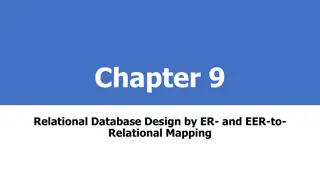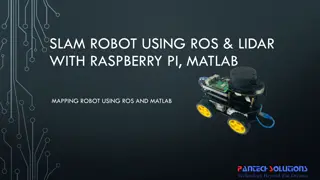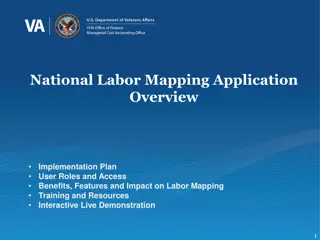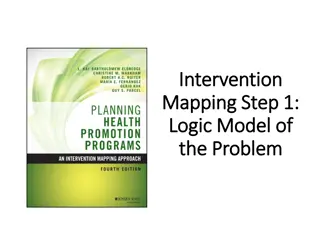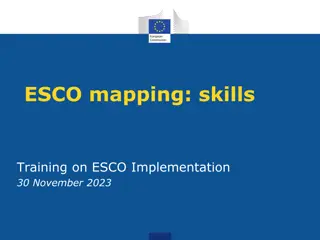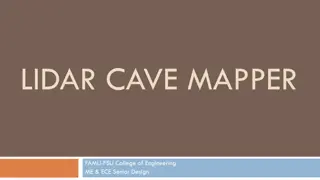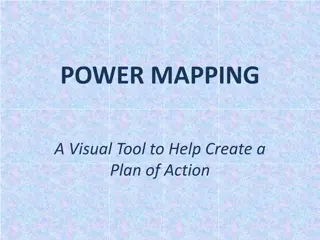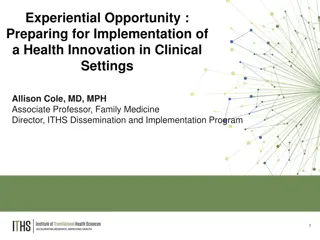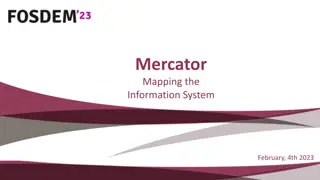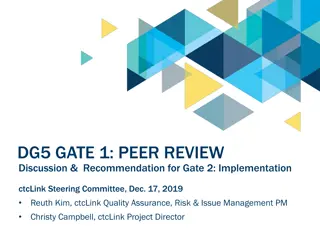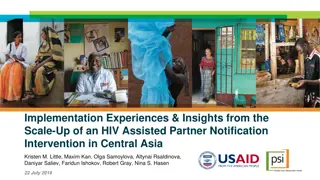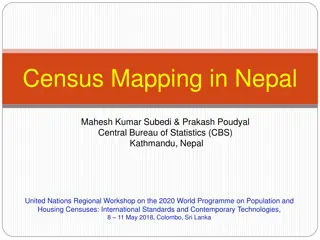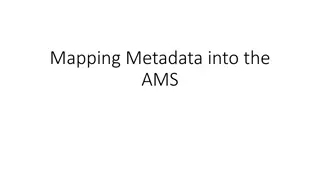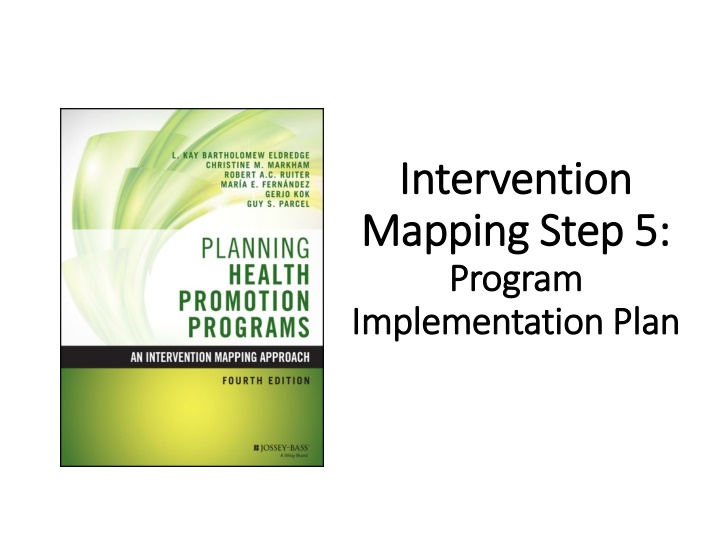
Intervention Mapping Step 5: Program Implementation Plan
The success of health education or promotion programs depends on careful planning for implementation and dissemination. Step 5 focuses on designing interventions to ensure programs are used as intended and scaled up for wider impact, incorporating theories and frameworks for effective dissemination and implementation.
Download Presentation

Please find below an Image/Link to download the presentation.
The content on the website is provided AS IS for your information and personal use only. It may not be sold, licensed, or shared on other websites without obtaining consent from the author. If you encounter any issues during the download, it is possible that the publisher has removed the file from their server.
You are allowed to download the files provided on this website for personal or commercial use, subject to the condition that they are used lawfully. All files are the property of their respective owners.
The content on the website is provided AS IS for your information and personal use only. It may not be sold, licensed, or shared on other websites without obtaining consent from the author.
E N D
Presentation Transcript
Intervention Intervention Mapping Step 5: Mapping Step 5: Program Program Implementation Plan Implementation Plan
Intervention Mapping Steps 1. Logic model of the problem 2. Program outcomes and objectives (logic model of change) 3. Program design 4. Program production 5. Program implementation plan 6. Evaluation plan 2
Planning for Program Use is Essential The ultimate impact of a health education or health promotion program depends on: Effectiveness of the intervention Reach in the population 3
Focus of Step 5 For new programs, demonstration, and research projects: Plan for initial implementation to ensure program is used as intended during the evaluation trial For programs that have already been implemented and evaluated: Develop an implementation intervention to enhance dissemination or scale-up for widespread use 4
EBI and Implementation Intervention Targets and Outcomes INSERT Figure 8.1 HERE Figure 8.1 5
Using Dissemination and Implementation Theories and Frameworks Diffusion of Innovations Theory Theories of Organizational Change RE-AIM Interactive Systems Framework Consolidated Framework for Implementation Research 6
Step 5: Tasks 1.Identify potential program implementers 2.State outcomes and performance objectives for program use 3.Construct matrices of change objectives for program use 4.Design implementation interventions 7
Task 1: Identify Potential Program Implementers Who will decide to adopt and use the program? Which stakeholders will decision makers need to consult? Who will make resources available to implement the program? Who will implement the program? Will the program require different people to implement different components? Who will ensure that the program continues as long as it is needed? 8
Task 2: State Outcomes and Performance Objectives for Program Use Program use outcomes Adoptionis a decision to use a new program Implementationis the use of the program to a fair trial point Maintenanceis the extent to which the program is continued and becomes part of normal practices and policies 9
Stating Performance Objectives for Program Use Performance objectives make clear who has to do what for the program to be adopted, implemented, and continued Step 5 performance objectives are similar to those in Step 2 for behavior and environmental outcomes except that the outcomes in Step 5 are program adoption, implementation, and maintenance
Adoption Outcome [Someone] adopts the [innovative program] as indicated by [the evidence to indicate adoption] The management team at [each] clinic decides to adopt the Peace of Mind Program (PMP) as indicated by the clinic director signing a memorandum of understanding
Example Performance Objectives for Adoption The Management Team members will: Review PMP materials and evaluation results Compare the intended outcomes with current mammography services and completion rates Agree to participate in the PMP Agree to expand mammography services Provide a program champion for the PMP Review the PMP program manual including phone- counseling scripts (cont d )
Continued Work with partners to draft, edit, and sign the Memorandum of Understanding (MOU) Gain support from stakeholders reaction to the program (care providers, decision makers, navigators/schedulers, patients) 13
Implementation Outcome The [organization or individual] will implement [innovative program] including use of [program components] The [clinic managers and staff] will implement [the PMP program] including use of [all program components]
Example Performance Objectives for Implementation Clinic decision makers will: Communicate with staff about practice change/role changes for patients due for mammography Designate time for EBI training Program champion will: Arrange for any change to EHR or reporting for PMP Arrange for patient referrals for mammograms Patient navigator will: Conduct telephone barrier counseling Use active-listening protocol when talking with patient
Maintenance Outcome Decide on the type of outcome to be achieved: Institutionalization (integration into organization s routines) continuation of health effects some combination of these Clinic leadership will maintain the PMP as part of a clinic s standard practice for every appointed mammography patient after initial funding is withdrawn
Example Performance Objectives for Maintenance Program champion will: Discuss with decision makers the continuation of the PMP after funding Work with decision makers to continue contractual arrangements for increased mammography services Add PMP tasks to normal clinic reminder calls Ensure that no-show rates continue to be reported (and remain stable or on a downward trend) Clinic decision makers will: Approve steps to ensure integration of the PMP into normal clinic routines
Task 3: Construct Matrices of Change Objectives for Program Use Use Core Processes to select determinants of program use Pose a question (Why would adopters decide to use the program?) Brainstorm a list of provisional answers Review the theoretical and empirical literature to refine or add to list Collect new data from potential program adopters and implementers 18
Example Determinants Awareness of the program Perceptions about the program s characteristics Perceived benefits of program use Self-efficacy and skills for implementation Values supportive of program goals
Social or Structural Factors Time Resources Social support Reinforcement
Partial Matrix for Adoption INSERT FIRST PAGE OF TABLE 8.1 HERE Partial Table 8.1 21
Task 4: Design Implementation Interventions The final task in Step 5 (similar to Step 3) is to develop an implementation intervention to influence program use Choose change methods and practical applications Design the scope and sequence Produce materials for an implementation intervention to influence program use 22
Example Implementation Intervention Plan INSERT TABLE 8.2 HERE Table 8.2 23
Example It s Your Game Keep It Real (IYG) A sexual health education program for middle school students 24
Task 1: Identify Potential Program Implementers Decision makers for Adoption School District School Health Advisory Council (SHAC) School Board Members & Superintendent School Level Principals Decision makers for Implementation Principal Physical education teachers Computer laboratory or library staff 25
Continued Decision makers for Maintenance School District School Health Advisory Council (SHAC) School Board Members & Superintendent School Level Principals 26
Task 2: State Outcomes and Performance Objectives for Program Use The planning group use theoretical and empirical evidence to develop four outcomes and related performance objectives for program use 27
Program Outcomes Adoption The SHAC will recommend and support the delivery of It s Your Game Keep it Real (IYG), an effective HIV, STD, and pregnancy prevention program, in their district School principals, parents and other community members will adopt and support the delivery of IYG Implementation Principals, physical education teachers, and other necessary staff will implement IYG Maintenance The SHAC, district administrators, principals, physical education teachers, and other necessary staff will maintain the delivery of IYG in their district and middle schools
Task 3: Partial Matrix for Adopters Determinants Performance Objectives A. Awareness / Knowledge B. Attitudes C. Outcome Expectations D. Perceived Norms 1. The SHAC evaluates student education needs in HIV, STD, and pregnancy prevention in their district 1a. List resources which can evaluate students educational needs 1b. Summarize sexual behavior, HIV, STD, and pregnancy statistics among students 1c. List the Health TEKS objectives for middle school students 1.d. Describe school policy on HIV, STD and pregnancy prevention education. 1e. Prioritize needs 1a. Describe review time and effort as necessary and important 1a. Expect that by evaluating student educational needs in HIV, STD, pregnancy prevention, problem can be prioritized and these statistics can be decreased 1.b. Expect that by not thoroughly fulfilling educational needs in HIV, STD and pregnancy prevention overall student success will decrease 1a. Recognize that other school districts see this as a problem that needs to be addressed 2. The SHAC reviews the It s Your Game Keep it Real (IYG) program and specifically note program objectives, methods, and relative advantages 2a.Describe IYG objectives and describe applicable TEKS objectives. [Compatibility] 2b. Describe how IYG compares to current HIV, STD, and pregnancy prevention curriculum coverage in HISD middle schools 2c. List advantages of IYG program (curriculum approved by the SHAC, is flexible, effective, interactive, easy to implement, fun for students and teachers) 2a.Describe IYG as being worth the modification to school level curriculum 2.b. Review characteristics of IYG in favorable manner. 2a. Expect that many Health TEKS objectives will be covered by implementing IYG in schools 2.b. Expect that IYG will be easy to implement and thus will easily fit in their allotted time for the health curriculum 2a. Principals, Teachers and parents support IYG curriculum
Partial Matrix for Implementers (Teachers) Determinants Performance Objectives A. Awareness / Knowledge B. Attitudes C. Outcome Expectations D. Skills and Self- Efficacy 1. All teachers attend It s Your Game Keep it Real training 1a. Describe where training is and how it will be covered (substitute coverage, during training day, etc) 1b. Describe the training as useful and necessary 1c. Expect that by attending the training they will be able to successfully implement program and students will benefit 1d. Demonstrates ability to attend the training and expresses confidence to do so 2. Teachers plan how and when It s Your Game Keep it Real will be implemented 2ai. Describe which lesson plans will be incorporated into the curriculum 2aii. Describe when the lessons will be implemented during allotted health class time 2b. Feels the IYG program will enhance their overall lesson plans for students 2c. Expects that IYG program lessons are adaptable and therefore easy to include in curriculum 2d. Demonstrate ability to fit lessons into yearly plan and expresses confidence in ability to do so
Task 4: Design Implementation Interventions INSERT TABLE 8.4 HERE Table 4 31
Teacher Training Topics Overview of IYG curriculum Adolescent sexual health Life skills (decision-making, communication and refusal skills) Puberty Healthy relationships HIV, STD, and teen pregnancy Lesson demonstration and modeling Interactive lesson practice and feedback Strategies for classroom management Guidelines for adapting the curriculum Action planning for effective implementation 32
Summary IM Step 5 comprises 4 key tasks: 1. Identify potential program implementers 2. State outcomes and performance objectives for program use 3. Construct matrices of change objectives for program use 4. Design implementation interventions

